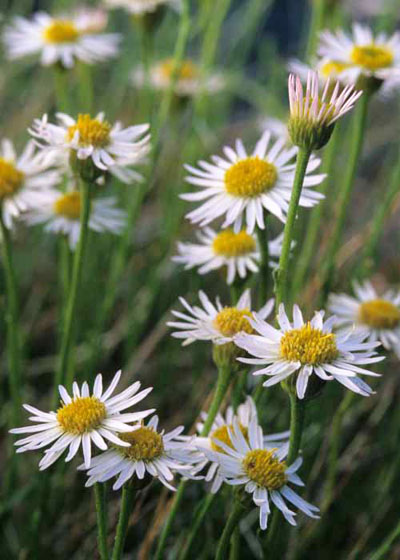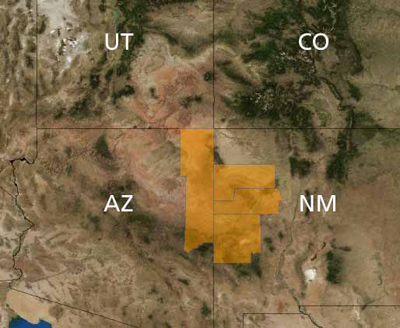Habitat and Ecology

© Robert Sivinski
Zuni fleabane (Erigeron rhizomatus) is known from about 20 scattered populations in the Zuni, Datil, and Sawtooth mountain ranges in west-central New Mexico, and in the Chuska Mountains in northeastern Arizona. It favors a specific type of habitat, usually on erodible, crustless soils on fine-textured, red clay hillsides. These habitats are found at elevations between 2225 and 2440 m (7300 and 8000 ft), and never on slopes with a southern aspect. Zuni fleabane occurs within pinyon-juniper woodlands, but the specific habitat where Zuni fleabane grows is sparsely vegetated. These habitats receive 35-40 cm (14-16 in) of precipitation a year.
Description
Zuni fleabane is a perennial herb that forms clumps of erect stems. The stems arise from rhizomes (underground stems) and have straight, stiff hairs. Few leaves occur on the flowering stems, but many leaves crowd the non-flowering stems. Each narrow leaf is less than 1 cm (0.4 in) long, does not have hairs, and is dark green. Single flowerheads occur on the ends of the branches. Each flowerhead has yellow disk flowers that make up the center of the flowerhead and 25-45 white or blue ray flowers that make up the outer petals of the flowerhead. The ray flowers are 0.6 cm (0.25 in) long. The flowers develop into achenes (a dry, one-seeded fruit with a thin wall that does not open at maturity; for example a sunflower “seed”) with 25-30 conspicuous bristles on one end. Zuni fleabane flowers from mid to late May, and the mature seeds fall by the end of July. Although Zuni fleabane produces many seeds, it propagates mostly from rhizomes.
Conservation Status and Threats

FWS
The U.S. Fish and Wildlife Service has listed Zuni fleabane as a threatened species since April 24, 1984. Arizona lists it as critically imperiled, and New Mexico and the Navajo Nation list it as imperiled.
Zuni fleabane is threatened mainly by uranium mining. Most Zuni fleabane populations occur on sites with historic or current mining claims for uranium. Other potential threats include off-road vehicles and erosion from grazing.
Related species
Erigeron rhizomatus is one of 171 of the genus Erigeron in North America.
References
Arizona Game and Fish Department. No date. Erigeron rhizomatous. Plant Abstract. Heritage Data Management System, Arizona Game and Fish Department, Phoenix, AZ. Available at http://www.azgfd.gov/w_c/ edits/documents/Erigrhiz.d_000.pdf (accessed 11 October 2010).
NatureServe. 2009. Erigeron rhizomatus. NatureServe explorer: An online encyclopedia of life. Version 7.1. NatureServe, Arlington, VA. Available at http://www. natureserve.org/explorer/ (accessed 7 October 2010).
U.S. Fish and Wildlife Service. 1985. Final rule to determine Erigeron rhizomatus to be a threatened species. Federal Register 50(81):16680-16682.
U. S. Fish and Wildlife Service. 1988. Zuni fleabane (Erigeron rhizomatus) recovery plan. U.S. Fish and Wildlife Service, Albuquerque, NM. Available at http://ecos.fws.gov/docs/recovery_plan/880930.pdf (accessed 7 October 2010).
Prepared by Kelly Reeves, Southern Colorado Plateau Network Inventory and Monitoring Program, 2010.
Last updated: July 29, 2015
